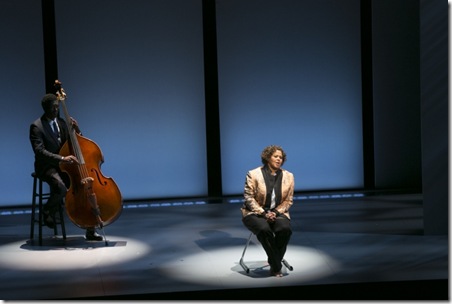Notes from the Field: Doing Time in Education at the American Repertory Theatre.
Notes from the Field: Doing Time in Education – Learning from Anna Deavere Smith. Directed by Leonard Foglia .
Photo: Evgenia Eliseeva
This production, premiering at Cambridge’s American Repertory Theatre, while it stands alone as a work of art, is the latest piece in Anna Deavere Smith’s long-term project “On the Road: A Search for American Character.” Three of her earlier works have played at the A.R.T. Fires in the Mirror dealt with the Crown Heights riots in which two minority groups, Blacks and Hasidic Jews turned against each other following an automobile accident in which the Jewish religious leader struck two black children, killing one and injuring the other. Twilight: Los Angeles, 1992 revolved around the violent events that followed the acquittal of the white police officers who had brutally beaten Rodney King, a black man. Let Me Down Easy, although political in that it addresses health care in the US and was created in the midst of the long hard fight to extend government aid to those unable to pay for private insurance, also recounted tales of athletes on drugs, and focused more on stories of celebrities than is her wont.
With Notes From the Field: Doing Time in Education, Smith explores similar material to that found in Twilight: Los Angeles, 1992. But here as the title indicates, the villain is a still segregated education system, which serves as a “pipeline” to deliver its victims, mostly poor minority males, into prison. Bored children in inadequate, crowded schools are more likely to act out and be given in-school detention as punishment by their overworked teachers. They don’t learn and fall further and further behind, often ending up as illiterate inmates. The nineteen characters, all enacted by Anna Deavere Smith, consist in the first act of former prisoners, a teacher, principal and other educational specialists, a pastor, a judge, a Latina mother, a journalist, and a high school student. Smith is accompanied by Marcus Shelby a bassist who composed the music for this production.
Act one is divided into six titled parts, beginning with a prologue followed by the first story “The Baddest.” Taos Proctor, a member of California’s Yurok tribe, is a former student failure and inmate who went through the criminal justice system from the juvenile facilities to state prison. Dressed in orange overalls, Smith’s Proctor is a burly, tough guy able to survive in prison because of his physical strength, ability to fight, and lack of fear.
His narrative is picked up later in “Compassion” which introduces Abby Abinati, the Chief Judge of the Yurok Tribe. She has arranged Proctor’s release from prison and is overseeing his adjustment to living peacefully with the tribe. She feels that his love for his little boy will give him the strength of will to stay out of trouble.
From California the play moves to Baltimore and Freddy Gray’s death and the protests that ensued. Smith is strikingly powerful as Pastor Jamal-Harrison Bryant who gave a hair raising funeral oration.
Anna Deavere Smith’s plays are docudramas based on abridged, but verbatim interviews with people involved in the events she reports. She uses few props and speaks directly to the audience, while creating the feeling that the character is talking to the interviewer. In this play, she does a costume change of sorts for each character as she makes her rapid transitions. Her performance is dependent on finding the right vocal inflections, accents, gestures, and body language. At moments, she brings a strong comedic flavor to her acting. Although a forceful and believable performer, she does not inhabit the character in the same way an actor would in a realistic play. Her acting style in her own works is to comment rather than be.
Doing Time in Education is divided into three sections. Act one, which runs about ninety minutes, puts forth the stories. In Act two the audience is divided into groups of about twenty people, each led by a facilitator. The purpose is to introduce the “national conversation on race,” which is always being called for and never formalized. Unfortunately, in my group the time allotment of twenty-five minutes prevented a dialogue of any depth from being held.
The short last act, called here the Coda, presents black people who escaped the pipeline and become heroes of the civil rights movement. Smith portrays writer James Baldwin as exaggeratedly affected in his interview with Margaret Mead. Bree Newsome’s story of climbing a pole in July 2015 to remove the confederate flag in Charleston, South Carolina is thrilling. Smith’s portrait of Sherrilyn Ifill, the president of the NAACP, presents a woman of great dignity who has spent her life working for justice and the improvement of education. Most moving of all is Smith’s performance of Congressman John Lewis recounting events of his past.
Riccardo Hernadez’s minimalist set consists of six movable panels separated by vertical lines which resemble prison bars when the panels are closed. Various panels also serve as screens for projections, which are well used.
This is an important piece of political theatre, well played and directed that has a great deal to say about the problems caused by unequal education. It is thought provoking, engrossing, and entertaining.
The play runs until September 17, 2016 at the Loeb Drama Center, Cambridge, MA.
